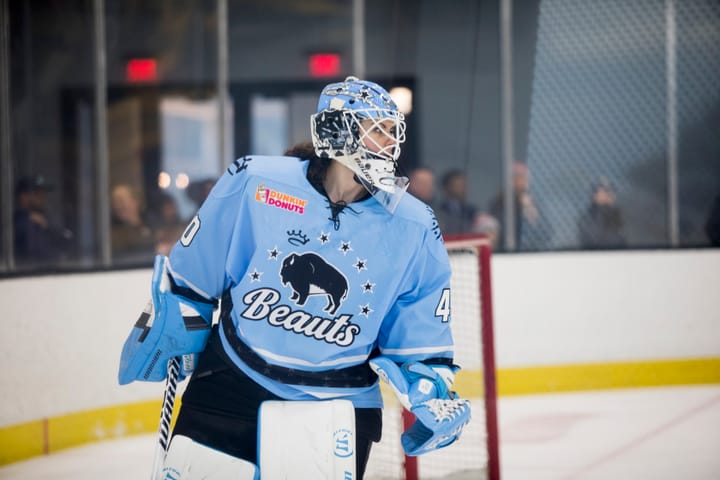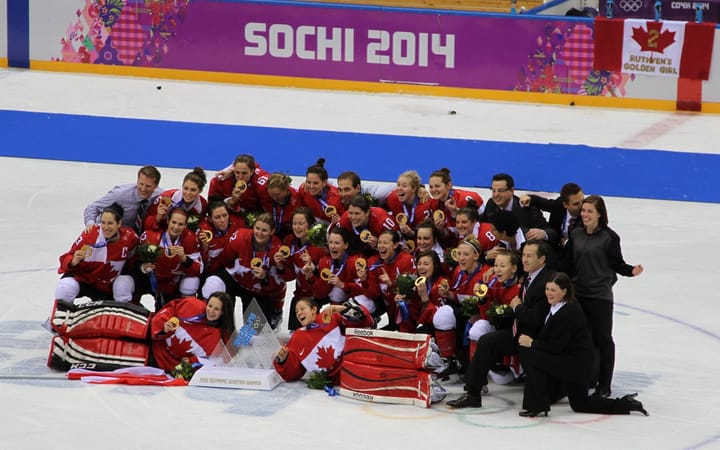How the Riveters’ Black Rosie jerseys came to be
The idea of a Black Rosie jersey has existed for seasons, but thanks to the right people being given the right opportunities, it’s finally become a reality
The Metropolitan Riveters’ Black Rosie jersey has been years in the making.
When the jersey made its on-ice debut on February 26, it was truly the culmination of a collaborative effort between many different people around and within the Riveters’ organization.
The jersey was designed by Jordan Dabney and uses a colour palette of red, green, and black, and features simple (yet bold) linework. The Riveters have used an image of the iconic Rosie the Riveter on their jerseys for years, but up until this season, Rosie was always represented as a white woman. The logo was redesigned ahead of Season 7 to a colourless Steel Rosie in an effort to make Rosie non-racial and more inclusive for all players and fans.
The new alternates put a Black Rosie the Riveter front and centre.
Erica Ayala, who works with the Riveters as a storyteller, and with the league as a broadcaster, says that the idea of a Black Rosie is an idea that’s existed since the earliest days of the franchise.
“People had seen mock-ups of a Black Rosie design back when they were still known as the New York Riveters,” Ayala said.
The team didn’t end up using a Black Rosie logo, but Ayala remembers seeing Katie Fitzgerald’s goalie helmet in 2017 when she played for the Riveters. The design featured two riveters on either side designed to look as if they were fastening her cage to the helmet with rivets. One of the women was Black and that struck Ayala. Even during Black History Month, society does a poor job of recognizing and honouring Black history. Fitzgerald’s helmet recognized and honoured the fact that many Black women worked as riveters during World War II.
It was around that time that Ayala reached out to Dabney, who is also the designer for the Black Girl Hockey Club. Together they worked to create the Black Rosie logo that Ayala uses and will continue to use as part of her own merch and branding. It was always a possibility that the Riveters would use a Black Rosie logo on a jersey in the future, so Ayala wanted her Rosie to be distinct. She holds a microphone above her head, a fitting choice to represent the first and only Black and Latine broadcaster in the PHF.
When Anya Packer became the General Manager of the Riveters, all the people who had been campaigning for a Black Rosie jersey were finally brought to the forefront.
“I know Anya has been thinking about this for at least two seasons now,” said Ayala.
For the people involved in making the jerseys into a reality, it was a matter of finally having the budget and the opportunity. Jasmine Baker has a lot of experience creating the kind of merch that fans actually want to wear and get excited about, she was brought on as the Director of Brand Strategy this season. Players were involved as well, continuing the conversation and talking about Black Rosie within the organization, including former Riveter Rebecca Morse and current captain, Madison Packer.
Dabney was approached by the team to design the jersey and remembers being surprised, excited, and unsure how to respond to the initial email.
“I was actually at my first Capitals away game, so I didn’t see the email until after,” she said.
It took a few days to respond to the email, but once she was able to ask questions about what exactly the Riveters wanted, she got to work. There were many drafts created and exchanged. There are a lot of bad jerseys out there, and Dabney wanted to make sure that her design was simple, clean, and did Black Rosie justice.
One thing that she and the Riveters established from the beginning is that the jerseys would be red. Dabney created many drafts in the process, with many different secondary colours, but the one they ended up going with features green, black, and white stripes.
“The one that I liked the most happened to be the one that they liked the most too,” Dabney said.
She chose colours traditionally associated with Africa and African culture and carried that into smaller more intricate elements of the design. The green stripes feature patterns inspired by traditional African prints.
🗣 BLACK ROSIE
— Metropolitan Riveters (@Riveters) February 26, 2022
So, so, well done @notafan_jo! pic.twitter.com/hRbu71LxAf
For Dabney, the opportunity to celebrate Black people in hockey is personal. As a Black woman, representation has been hard to come by. When she was first getting into the sport, she often noticed a lack of Black people on the ice and within fan spaces.
“It was like, am I the only one? I was googling, ‘Are there Black people who like this sport?’”
It was important that the debut of the Black Rosie jerseys was about more than just unveiling a new alternate. The Riveters needed to honour the history of Black people in hockey to really show what Black Rosie represents. For Ayala especially, having Cherie Stewart there was a must. Stewart is the first Black person to play for the Metropolitan Riveters, and her presence on the ice was important to Ayala as she began to love the game.
This right here 🥰💪🏽@cheriestewy, the first Black New York Riveter@notafan_jo, the #BlackRosie designer! #BlackHockeyHistory #HockeyTwitter #TeamMoreMelanin pic.twitter.com/oHnjH3GHxi
— Erica L. Ayala 💪🏽 (@elindsay08) February 27, 2022
“I got into hockey because my sister saw Julie Chu on the ice as the only person of colour, so I started taking her to games. I fell in love because I saw Blake Bolden, Cherie Stewart, the names really go on and on,” she said.
Cherie Stewart was in attendance at the game on February 26. She and Dabney were able to meet and have a conversation, that was the moment that the emotion hit Ayala.
In hockey, it has too often taken far longer than it should for Black players to get the recognition that they deserve. It took until 2018 for Willie O’Ree to be inducted into the Hall of Fame and only recently have we finally begun to celebrate his legacy and talk about his impact on the sport.
The history of the PHF is relatively recent in the grand scheme of things, and Black players continue to play and do amazing things. There’s no reason not to honour the history that these players are making, especially as it happens right before our eyes.
Black Rosie and the Metropolitan Riveters are just the beginning.





Comments ()